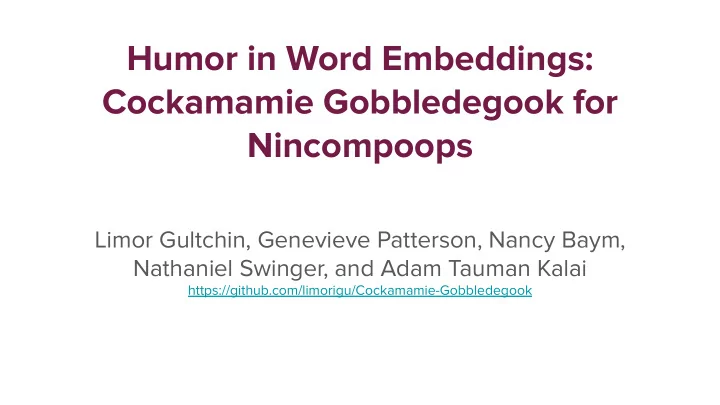

Humor in Word Embeddings: Cockamamie Gobbledegook for Nincompoops Limor Gultchin, Genevieve Patterson, Nancy Baym, Nathaniel Swinger, and Adam Tauman Kalai https://github.com/limorigu/Cockamamie-Gobbledegook
Toolkit: Word embeddings ● Allowing us to relate words to each other, similarity is defined by distance to neighboring vectors. Each word is represented as a high dimensional vector (learned by a pre-trained neural network on some corpora) Similarity between words can then be captured and computed via cosine similarity, and even define ● logical analogies TensorFlow embedding projector
Original Data collection (From Mechanical Turk) Additional dimensions of data: Humor theory features Yes/No Is ‘yadda yadda’... Funny sounding 1 Juxtaposition 2 Sexual 3
Our approach Can we use word embeddings to capture 1 humor theories and a humor direction? Can we identify different 2 senses of humor across demographic groups? v2 (new v1 (new Can we define individual 3 word ?) word ?) sense of humor and predict users’ taste? R2 (user 2 r1 (user 1 mean) mean)
1 Can we use word embeddings to capture humor theories and identify a ‘humor direction’? ● Ridge regression to predict theory rating (average of 8 users) from word embedding vector for each word (90-10% train/test split) ● Correlation b/w predictions and actual ratings ‘Predictability score’=mean over ● 1,000 runs
2 Can we identify different senses of humor across demographics? ● K-means clustering of individuals’ average vector of 36 favourite words ● Demographics of each cluster uncovered later ● ‘Most characteristic’ word for cluster defined as
3 Can we define individual senses of humor and predict users’ taste? ● Define a mean vector of words rated funny for each user ● ‘Know-your-audience’ test, match unseen words to the right individual (see formula) ● Compute accuracy score
Recommend
More recommend